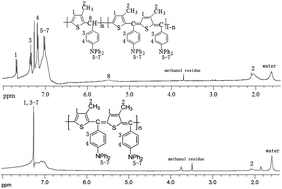Preparation and thermoelectric properties of diphenylaminobenzylidene-substituted poly(3-methylthiophene methine)/graphite composite
Abstract
Polymer–inorganic composites show great potential for use as thermoelectric (TE) materials. However, the TE performance of these materials needs to be improved. One way to improve the TE performance would be to synthesize novel conductive polymers with high Seebeck coefficients to prepare polymer–inorganic TE composites. In this study, acidized and ammoniated forms of poly[(3-methylthiophene-2,5-diyl)(diphenylaminobenzylidene)(3-methylthiophene quinodimethane-2,5-diyl)] (PMTDPABQ) were successfully synthesized with high Seebeck coefficients. These polymers were used to prepare a series of PMTDPABQ/graphite (G) bulk composites by mechanical ball milling and cold pressing. The morphology, thermal stability, and TE performance of these composites were evaluated. The G was uniformly dispersed in the polymer matrix, and the composite materials exhibited good thermal stability at temperatures up to 200 °C. The acidized PMTDPABQ/G composites exhibited better TE performance than the ammoniated PMTDPABQ/G composites. The highest TE figure of merit, ZT = 5.32 × 10−3, was obtained using acidized PMTDPABQ/G and was approximately 3 times greater than that of polythiophene (PTh)/G (1.37 × 10−3).


 Please wait while we load your content...
Please wait while we load your content...